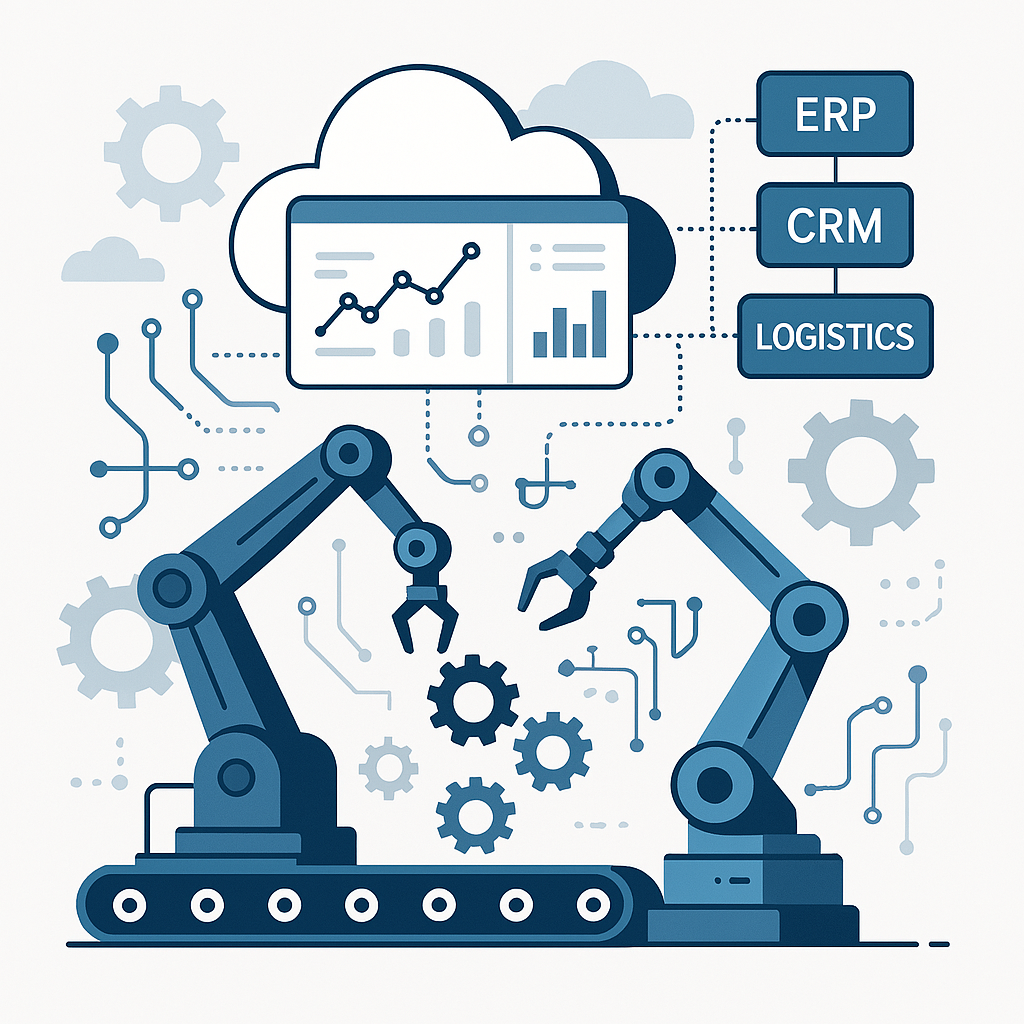The Digital Backbone of Modern Manufacturing: Trends in Backend Software and Workflow Integration
In 2025, the manufacturing sector – particularly in the UK and USA – is undergoing a profound transformation. While much attention is given to robotics, AI, and smart factories on the production floor, an equally important revolution is happening behind the scenes: the modernization of backend business software.
From quoting and CRM to invoicing and delivery logistics, manufacturers are embracing end-to-end digital workflows that streamline operations, improve customer experiences, and boost profitability. This article explores the key trends shaping this shift and how integration tools are becoming the unsung heroes of modern manufacturing.

🌍 Global and Regional Trends in Backend Software Adoption
 UK Manufacturers
UK Manufacturers
UK firms are increasingly adopting cloud-based ERP and CRM systems to overcome legacy system limitations. With government incentives for digitalisation and decarbonisation, there’s a strong push toward platforms that support real-time data, remote access, and modular scalability.
 US Manufacturers
US Manufacturers
In the US, the focus is on automation and AI-enhanced platforms. Manufacturers are leveraging tools like Salesforce, ServiceNow, and Microsoft Copilot to automate quoting, customer support, and analytics – freeing up teams to focus on value-added tasks.
🌐 What’s Trending in 2025?
Here’s what small manufacturers in the UK, USA, and around the world are doing to modernize their backend operations:
✅ Cloud-Based ERP and CRM Systems
- Manufacturers are moving away from on-premise systems to cloud-based ERP and CRM platforms like HubSpot, Salesforce, and Microsoft Dynamics 365.
- Cloud solutions offer scalability, real-time data access, and lower upfront costs, which are especially attractive to SMEs.
✅ Integration of Generative AI
- AI is being embedded into CRM and ERP systems to automate:
- Quote generation
- Customer support (via chatbots)
- Predictive analytics for sales and inventory
- Tools like Salesforce Einstein and Microsoft Copilot are leading this transformation
✅ End-to-End Workflow Automation
- Manufacturers are adopting platforms that integrate quoting, ordering, invoicing, and inventory into a single workflow.
- This reduces manual data entry and improves accuracy and speed.
✅ Low-Code/No-Code Customization
- Backend platforms now offer low-code tools for customizing workflows without needing deep IT expertise.
- This empowers operations and sales teams to adapt systems to their needs quickly.
✅ SaaS and Modular Software Adoption
- Businesses prefer modular SaaS platforms that allow them to start small (e.g., just CRM or quoting) and expand as needed.
- Examples include Zoho, Odoo, and HubSpot for smaller manufacturers.
✅ Cybersecurity and Compliance Focus
- With increasing digitalization, there’s a strong emphasis on data security, especially for customer and financial data.
- Compliance with standards like ISO 27001 and GDPR is a growing priority.
✅ Mobile-First and Remote Access
- Backend tools are increasingly mobile-friendly, enabling field sales teams and remote workers to access systems on the go.
🔄 The Shift Toward End-to-End Workflow Integration
Manufacturers are moving away from siloed systems and spreadsheets toward connected digital ecosystems. The goal? A seamless flow of data from the first customer interaction to the final delivery of goods.
This shift is driven by several factors:
- Customer expectations for faster, more accurate service
- Rising operational complexity across quoting, inventory, and logistics
- Global competition demanding greater efficiency and agility
An end-to-end workflow might start with a quote generated in QuoteWerks, flow into Microsoft Dynamics CRM for customer management, sync with Business Central or Sage 200 ERP for order processing, and finally coordinate delivery via FedEx, UPS, or even What3Words for pinpoint accuracy.
🧩 The Power of Integration: Making Systems Talk
While adopting modern software is a great first step, the real magic happens when these systems are integrated. That’s where our integration solutions come in.
We help manufacturers connect the dots between:
- QuoteWerks and Microsoft CRM, HubSpot, SalesForce.com or other CRM solution for seamless quoting and customer tracking
- Sage 50 Accounts, Sage 200 ERP, Microsoft Business Central or Pegasus Opera for unified financial and operational data
- T-Cards Online and ServiceNow for streamlined task and service management
- FedEx, UPS, Google Maps, and What3Words for smarter, more reliable deliveries
These integrations eliminate manual data entry, reduce errors, and ensure that every department – from sales to shipping – is working from the same playbook.
🚀 Why This Matters Now
In a world where speed, accuracy, and customer experience are competitive differentiators, manufacturers can no longer afford disconnected systems. Backend software is no longer just an administrative tool – it’s a strategic asset.
By embracing integrated, end-to-end workflows, manufacturers can:
- Respond to quotes faster
- Deliver more accurate orders
- Improve cash flow through timely invoicing
- Delight customers with precise, on-time deliveries
💡 Final Thoughts
The future of manufacturing isn’t just about smart machines – it’s about smart operations. And that starts with the software that powers your business behind the scenes.
If you’re ready to modernize your backend systems and unlock the full potential of your manufacturing workflow, we’re here to help. Our integration tools are designed to connect your favourite platforms – so you can focus on what you do best: building great products.
Contact Us today!
 Chat with Us
Chat with Us PREV
PREV